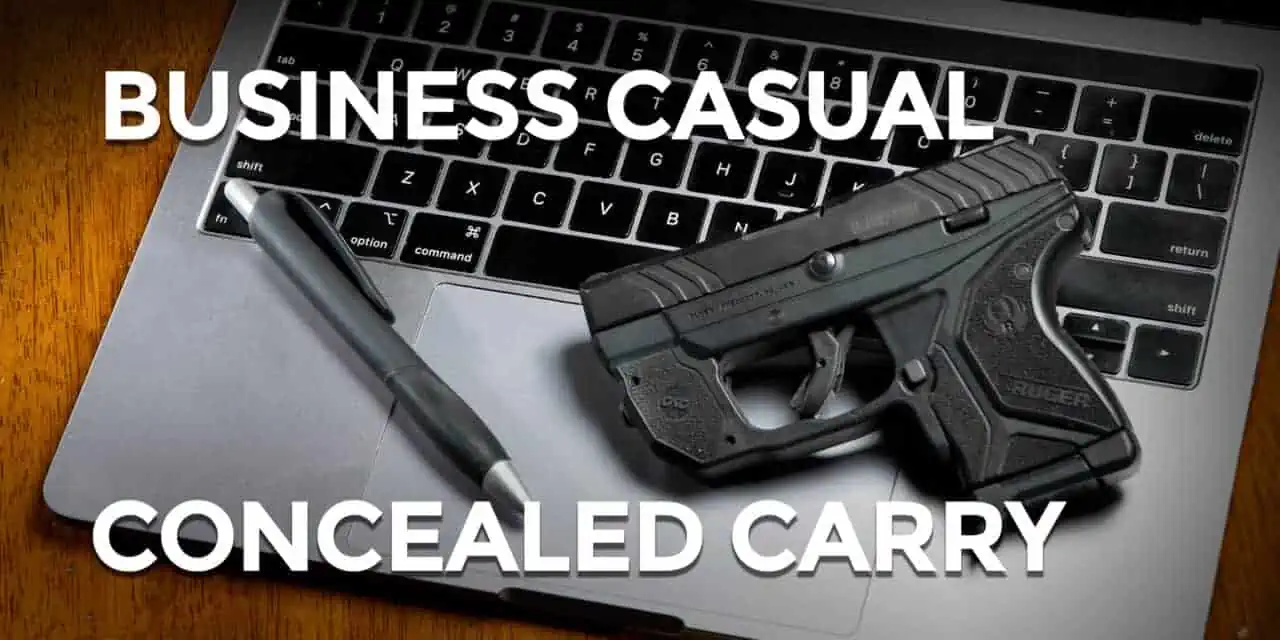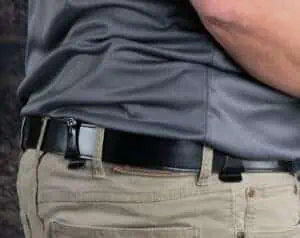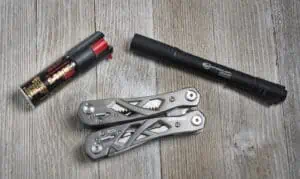Concealed Carry, Business Casual Style
When I first started carrying a defensive firearm on a regular basis, I looked around for tips and ideas on how to make the process a little bit easier. Carrying around a heavy lump of metal (or metal and plastic) is not something we normally do. Learning how to make concealed carry a part of my everyday routine took a commitment to putting my gun on every day, no matter if I “felt like I needed it” or not.
Carrying on the weekends or on days off was not a problem. There is plenty of advice out there on how to carry a defensive pistol if you’re wearing jeans and an untucked t-shirt, or if you’re wearing a loose, open jacket. However, when it came time to look for tips on how to carry at my office job, there was very out there for tips on business casual concealed carry.
There is a saying in the firearms training community that “Carrying a gun should be comforting, not comfortable.” This saying may work if you can adjust your clothing to be as comfortable as possible when carrying a gun, but this can cause problems for those of us who follow a dress code at work. Finding a way to carry a gun while I worked at a desk job proved to be quite a task. I eventually settled on using a small .380 auto in a pocket holster, but I knew there are other options out there.
Concealed Carry & Business Casual: Making Them Work
I made my choice based on the information I had at the time, and I think I did well. I no longer work in a business casual environment, though, and your choices for holsters have become even more diverse than they were a dozen years ago. So in order to see what business casual concealed carry options are out there for today’s gun owners, I reached out to Alex from The Suited Shootist to get some ideas about discreet concealed carry in an office environment.
The Suited Shootist is a website devoted to finding ways to bring concealed carry into the office in a safe and legal way. Alex’s philosophy on concealed carry is being armed and being well-dressed can go hand in hand. Even though I dress more casual these days, I appreciate his insights on keeping safe at work as well as in the home, so he was a natural person to talk with being armed in an office in general, and about business casual concealed carry in particular.
Style AND Firepower
“First off,” Alex says, “You have got to be 100% certain that having a gun in your workplace will not result in your termination,” and I wholeheartedly agree with this idea. The reason why we carry a gun is to keep ourselves safe from the bad things that might happen at work. A mugger in the parking garage is a bad thing, as is an active shooter in the workplace. Getting fired from your job because you broke company policy about guns in the workplace is also a very bad thing.
“Pay attention to not just the rules about firearms or other ‘weapons,’ but also other things inside the employee manual,” Alex says. “Can your employer search your desk at any time, with or without your permission? If this is so,” Alex continued, “you may really want to reconsider your decision to carry in the workplace, especially if you carry off-body. The bottom line is, getting fired for carrying a gun is definitely not fulfilling your role as a responsible armed citizen.”
“There are a number of options for business casual concealed carry,” Alex says. “First off, if you wear your shirt untucked, the sky’s the limit for what you can carry and where you can carry it. Appendix carry or inside the waistband carry are all easy to accomplish with an untucked polo shirt or something similar.”
Pitfalls of Business Casual and Concealed Carry
“However,” he continued, “once you tuck in your shirt, your options for concealed shrink significantly. Even if you use a tuckable holster, the clips needed to hold the holster in place stick out like a sore thumb. This can be mitigated somewhat with holster attachments that secure to the back of your belt with hook and loop fasteners, but even then, you’ll need to blouse out your shirt just right in order to conceal your gun and holster.”
As I mentioned before, I chose to pocket carry when I worked in an office, and Alex agrees that it allows you to be armed in the workplace, but you will have less gun at your disposal if the need arises.
“Pocket carry is probably the most discrete business casual concealed carry option there is,” he says, “however, your gun and holster choices are going to affect how noticeable your pistol is inside of your trousers. When carried in a good pocket holster, a flat .380 semiauto like the Ruger LCP results in a shape in your trousers that looks very innocuous, like a wallet or a small cell phone. In my experience,” he continued, “a small snub-nosed revolver looks like a big lump in your pocket, which might cause people to wonder.”
Other Options For Mixing Business Casual & Concealed Carry
As for ankle carry, the drawbacks outweigh any gains in convenience, says Alex. “I never could make ankle carry work,” he said. “The minute I crossed my legs, the bottom of the holster would peek out. And when you figure in the time it takes to get a gun into play from your ankle, it’s just not worth it.”
Alex went on to talk about other options for having a gun nearby inside an office. “You may find it tempting to carry your pistol with some form of off-body carry, such as a laptop case or day planner that are designed to conceal a pistol. I’d stay away from this method,” he said, “because if you ever lose track of your laptop or day planner, you’ve not only lost a computer, you’ve given a crook a free gun. Not a good idea.”
Alex, like me, is a big fan of less lethal options if you can’t carry a gun at your workplace. “Pepper spray has become so common, no one really freaks out if they find a canister on you.”
Alex has other suggestions for defending your life at your work, “Take a look around your office, and you’ll see plenty of items nearby that could make effective defensive tools. A dry chemical fire extinguisher, a sharp pair of scissors, a heavy laptop brick are just a few of the items that are common in the workplace but can really put the hurt on someone.”
Other Options For Staying Safe In The Office
In addition to these items, I’ve found that common everyday tools like a mulittool and a bright flashlight can provide some measure of security at the job and come in very handy as well. At night, a bright flashlight signals to any potential bad guy that you realize it’s dark outside and you’re prepared to do something about it. In addition to this, I’ve found that a flashlight comes in really handy when you’re searching for a lost power cord behind your desk or when the lights go out in the building.
Carrying a firearm inside your office might be an option for you. Less lethal might be an option for you as well, or you may have to rely on using what’s available around you to protect your life. Either way, mindset and situational awareness will provide you with the knowledge to stay safe, no matter what surroundings you might find yourself in.





